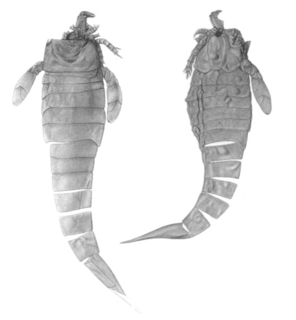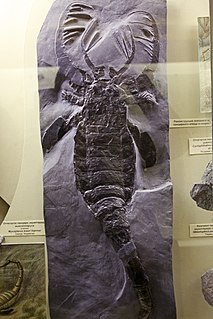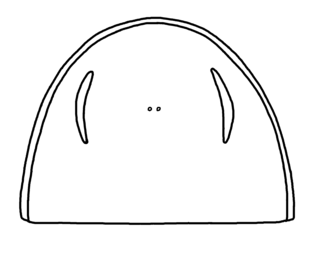 W
WAcutiramus is a genus of giant predatory eurypterid, an extinct group of aquatic arthropods. Fossils of Acutiramus have been discovered in deposits of Late Silurian to Early Devonian age. Seven species have been described, five from North America and two from the Czech Republic. The generic name derives from Latin acuto and Latin ramus ("branch"), referring to the acute angle of the final tooth of the claws relative to the rest of the claw.
 W
WBassipterus is a genus of eurypterid, an extinct group of aquatic arthropods. Bassipterus is classified as part of the family Adelophthalmidae, the only clade within the derived ("advanced") Adelophthalmoidea superfamily of eurypterids. Fossils of the single and type species, B. virgnicus, have been discovered in deposits of the Late Silurian age in West Virginia and Maryland, United States. The genus is named after Bass, where most of the fossils have been recovered.
 W
WBrachyopterella is a genus of prehistoric eurypterid classified as part of the Rhenopteridae family. Two species, both from the Silurian period, are known; B. pentagonalis from Norway and B. ritchei from Scotland.
 W
WBuffalopterus is a prehistoric eurypterid from the Silurian-aged Bertie Formation of New York and Ontario. The genus contains one species, B. pustulosus. It is closely related to Strobilopterus, but differs primarily by having a bizarre, globular telson, and in size, being estimated to be at least 1 meter in length.
 W
WCarcinosoma is a genus of eurypterid, an extinct group of aquatic arthropods. Fossils of Carcinosoma are restricted to deposits of late Silurian age. Classified as part of the family Carcinosomatidae, which the genus lends its name to, Carcinosoma contains seven species from North America and Great Britain.
 W
WCiurcopterus is a genus of eurypterid, an extinct group of aquatic arthropods. Fossils of Ciurcopterus have been discovered in deposits of Late Silurian age in North America. Classified as part of the family Pterygotidae, the genus contains two species, C. sarlei from Pittsford, New York and C. ventricosus from Kokomo, Indiana. The genus is named in honor of Samuel J. Ciurca Jr., who has contributed significantly to eurypterid research by discovering a large amount of eurypterid specimens, including the four specimens used to describe Ciurcopterus itself.
 W
WClarkeipterus is a genus of prehistoric eurypterid classified as part of the family Dolichopteridae. The genus contains two species, C. otisius and C. testudineus, both from the Silurian Bertie Formation of the United States.
 W
WCtenopterus is a genus of prehistoric eurypterid of the family Stylonuridae. It contains only one species, Ctenopterus cestrotus from the Early Silurian of Otisville, New York.
 W
WDolichopterus is a genus of prehistoric sea scorpions, arthropods in the order Eurypterida. Fossils of Dolichopterus have been discovered in deposits ranging from Silurian to Devonian, and have been referred to several different species, some of them of dubious affinity to this genus.
 W
WDrepanopterus is an extinct genus of eurypterid and the only member of the family Drepanopteridae within the Mycteropoidea superfamily. There are currently three species assigned to the genus. The genus has historically included more species, with nine species associated with the genus Drepanopterus, however five of these have since been proven to be synonyms of pre-existing species, assigned to their own genera, or found to be based on insubstantial fossil data. The holotype of one species proved to be a lithic clast.
 W
WErettopterus is a genus of large predatory eurypterid, an extinct group of aquatic arthropods. Fossils of Erettopterus have been discovered in deposits ranging from Early Silurian to the Early Devonian, and have been referred to several different species. Fossils have been recovered from two continents; Europe and North America. The genus name is composed by the Ancient Greek words ἐρέττω (eréttō), which means "rower", and πτερόν (pterón), which means "wing", and therefore, "rower wing".
 W
WErieopterus is a genus of prehistoric eurypterid found in Silurian to Devonian-aged marine strata of Europe and North America. The genus contains eight species from the Silurian to the Devonian, recovered from both North America and Europe.
 W
WEurypterus is an extinct genus of eurypterid, a group of organisms commonly called "sea scorpions". The genus lived during the Silurian period, from around 432 to 418 million years ago. Eurypterus is by far the most well-studied and well-known eurypterid and its fossil specimens probably represent more than 90% of all known eurypterid specimens.
 W
WEusarcana is a genus of eurypterid, an extinct group of aquatic arthropods. Fossils of Eusarcana have been discovered in deposits ranging in age from the Early Silurian to the Early Devonian. Classified as part of the family Carcinosomatidae, the genus contains three species, E. acrocephalus, E. obesus and E. scorpionis, from the Silurian-Devonian of Scotland, the Czech Republic and the United States respectively.
 W
WEysyslopterus is a genus of eurypterid, an extinct group of aquatic arthropods. Eysyslopterus is classified as part of the family Adelophthalmidae, the only clade within the derived ("advanced") Adelophthalmoidea superfamily of eurypterids. One fossil of the single and type species, E. patteni, has been discovered in deposits of the Late Silurian period in Saaremaa, Estonia. The genus is named after Eysysla, the Viking name for Saaremaa, and opterus, a traditional suffix for the eurypterid genera, meaning "wing". The species name honors William Patten, an American biologist and zoologist who discovered the only known fossil of Eysyslopterus.
 W
WHardieopterus is a genus of prehistoric eurypterid classified within the family Hardieopteridae. The genus contains four species, all Silurian in age; H. lanarkensis and H. macrophthalmus from Scotland, H. megalops from England and H. myops from the United States.
 W
WHerefordopterus is a genus of eurypterid, an extinct group of aquatic arthropods. Herefordopterus is classified as part of the family Hughmilleriidae, a basal family in the highly derived Pterygotioidea superfamily of eurypterids. Fossils of the single and type species, H. banksii, have been discovered in deposits of Silurian age in Herefordshire and Shropshire, England. The genus is named after Herefordshire, where most of the Herefordopterus fossils have been found. The specific epithet honors Richard Banks, who found several well-preserved specimens, including the first Herefordopterus fossils.
 W
WHolmipterus is a genus of eurypterid, an extinct group of aquatic arthropods. Fossils of Holmipterus have been discovered in deposits of the Sheinwoodian age in Europe. It only contains one species, which is in turn the type species, H. suecicus, from Gotland, Sweden. The generic name honors Gerhard Holm, a Swedish paleontologist whose work in the arthropods remains as a model to follow.
 W
WHughmilleria is a genus of eurypterid, an extinct group of aquatic arthropods. Fossils of Hughmilleria have been discovered in deposits of the Silurian age in China and the United States. Classified as part of the basal family Hughmilleriidae, the genus contains three species, H. shawangunk from the eastern United States, H. socialis from Pittsford, New York, and H. wangi from Hunan, China. The genus is named in honor of the Scottish geologist Hugh Miller.
 W
WKiaeropterus is a genus of prehistoric eurypterid classified as part of the Rhenopteridae family. Two species, both from the Silurian period, are known; K. cyclophthalmus from Scotland and K. ruedemanni from Norway.
 W
WKokomopterus is a genus of prehistoric eurypterid. The genus contains a single species, Kokomopterus longicaudatus, known from the Silurian of Kokomo, Indiana.
 W
WLanarkopterus is a genus of prehistoric eurypterid with one recognised species, Lanarkopterus dolichoschelus. Lanarkopterus was long seen as a species of the closely related Mixopterus, though more complete specimens discovered in the 1960s determined that it differed in several aspects, enough to warrant a separate genus.
 W
WLaurieipterus is a genus of a eurypterid classified as part of the family Stylonuridae. It contains one species, L. elegans from the Early Silurian of Scotland.
 W
WMixopterus is a genus of eurypterid, an extinct group of aquatic arthropods. Fossils of Mixopterus have been discovered in deposits from Late Silurian age, and have been referred to several different species. Fossils have been recovered from two continents; Europe and North America.
 W
WNanahughmilleria is a genus of eurypterid, an extinct group of aquatic arthropods. Fossils of Nanahughmilleria have been discovered in deposits of Devonian and Silurian age in the United States, Norway, Russia, England and Scotland, and have been referred to several different species.
 W
WNecrogammarus salweyi is the binomial name applied to an arthropod fossil discovered in Herefordshire, England. The fossil represents a fragmentary section of the underside and an appendage of a pterygotid eurypterid, a group of large and predatory aquatic arthropods that lived from the late Silurian to the late Devonian. The Necrogammarus fossil is Late Silurian in age and its generic name means "dead lobster", deriving from Ancient Greek νεκρός and Latin gammarus ("lobster").
 W
WOnychopterella is a genus of predatory eurypterid, an extinct group of aquatic arthropods. Fossils of Onychopterella have been discovered in deposits from the Late Ordovician to the Late Silurian. The genus contains three species: O. kokomoensis, the type species, from the Early Pridoli epoch of Indiana; O. pumilus, from the Early Llandovery epoch of Illinois, both from the United States; and O. augusti, from the Late Hirnantian to Early Rhuddanian stages of South Africa.
 W
WParahughmilleria is a genus of eurypterid, an extinct group of aquatic arthropods. Fossils of Parahughmilleria have been discovered in deposits of the Devonian and Silurian age in the United States, Canada, Russia, Germany, Luxembourg and Great Britain, and have been referred to several different species. The first fossils of Parahughmilleria, discovered in the Shawangunk Mountains in 1907, were initially assigned to Eurypterus. It would not be until 54 years later when Parahughmilleria would be described.
 W
WParastylonurus is a genus of prehistoric eurypterid. It is classified within the Parastylonuridae family and contains three species, P. hendersoni and P. ornatus from the Silurian of Scotland and P. sigmoidalis from the Silurian of England.
 W
WPittsfordipterus is a genus of eurypterid, an extinct group of aquatic arthropods. Pittsfordipterus is classified as part of the family Adelophthalmidae, the only clade in the derived ("advanced") Adelophthalmoidea superfamily of eurypterids. Fossils of the single and type species, P. phelpsae, have been discovered in deposits of Silurian age in Pittsford, New York state. The genus is named after Pittsford, where the two only known specimens have been found.
 W
WPterygotus is a genus of giant predatory eurypterid, a group of extinct aquatic arthropods. Fossils of Pterygotus have been discovered in deposits ranging in age from Late Silurian to Late Devonian, and have been referred to several different species. Fossils have been recovered from four continents; Australia, Europe, North America and South America, which indicates that Pterygotus might have had a nearly cosmopolitan (worldwide) distribution. The type species, P. anglicus, was described by Swiss naturalist Louis Agassiz in 1839. Agassiz mistakenly believed the remains were of a giant fish, with the name Pterygotus translating to "winged fish". He would only realize the mistake five years later in 1844.
 W
WRhinocarcinosoma is a genus of Silurian eurypterid, with a triangular carapace, laterally positioned eyes, and a curved telson. It is classified as part of the family Carcinosomatidae and contains three species, two from New York, United States and R. dosonensis, a species described in 2002 from the Dô Son Formation of the Dô Son Peninsula of northern Vietnam.
 W
WRuedemannipterus is a genus of prehistoric eurypterid classified as part of the family Dolichopteridae. The genus contains one species, R. stylonuroides, known from the Silurian of New York.
 W
WSlimonia is a genus of eurypterid, an extinct group of aquatic arthropods. Fossils of Slimonia have been discovered in deposits of Silurian age in South America and Europe. Classified as part of the family Slimonidae alongside the related Salteropterus, the genus contains three valid species, S. acuminata from Lesmahagow, Scotland, S. boliviana from Cochabamba, Bolivia and S. dubia from the Pentland Hills of Scotland and one dubious species, S. stylops, from Herefordshire, England. The generic name is derived from and honors Robert Slimon, a fossil collector and surgeon from Lesmahagow.
 W
WStoermeropterus is a genus of prehistoric eurypterid from the Silurian period in Europe and North America classified as part of the Moselopteridae family. The genus contains three species, S. conicus and S. latus from Ringerike, Norway and S. nodosus from West Virginia.
 W
WStrobilopterus is a genus of prehistoric eurypterid of the family Strobilopteridae. The genus contains four species, two from the Devonian of Wyoming, United States, one from the Devonian of Ohio, United States and one from the Silurian of Estonia.
 W
WStylonurella is a genus of prehistoric eurypterid. It is classified within the Parastylonuridae family and contains three species, S. arnoldi and S. beecheri from the Devonian of Pennsylvania, United States and S. spinipes from the Silurian of Kip Burn, Scotland.
 W
WStylonurus is a genus of prehistoric eurypterid of the family Stylonuridae. The genus contains three species: Stylonurus powriensis from the Devonian of Scotland, Stylonurus shaffneri from the Devonian of Pennsylvania and Stylonurus perspicillum from the Devonian of Germany.
 W
WTylopterella is a genus of eurypterid, a group of extinct aquatic arthropods. Only one fossil of the single and type species, T. boylei, has been discovered in deposits of the Late Silurian period in Elora, Canada. The name of the genus is composed by the Ancient Greek words τύλη (túlē), meaning "knot", and πτερόν (pteron), meaning "wing". The species name boylei honors David Boyle, who discovered the specimen of Tylopterella.
 W
WWaeringopterus is a genus of prehistoric eurypterids from the Silurian of North America. The genus contains two species, W. apfeli from New York and Ontario and W. cumberlandicus from West Virginia.